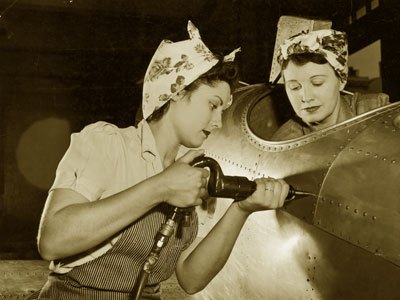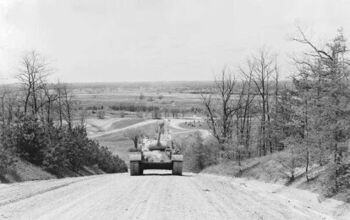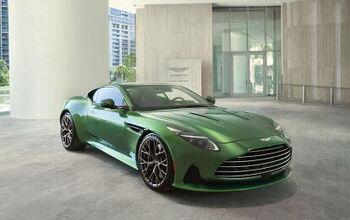For Memorial Day: The Arsenal of Democracy

Memorial Day is a time set aside to remember those who gave their lives in military service to the United States. Today, even as we are fighting two wars and have men and women in harms way in yet other places, though, a relatively small fraction of Americans serve in the military. Few civilians, except military families, understand the sacrifices necessary to protect our country. There was a time, though, when the military conflict was genuinely existential and just about every able bodied man was drafted or enlisted, while virtually the entire civilian population was directly involved in the war effort, either through their jobs in military production, or more personally, because just about everything was rationed giving the military a higher priority for things like vehicles, tires, fuel and food. With the dawn of total war, the plants and proving grounds of Detroit became a new kind of battlefield, in which the tools of economic prosperity were turned into munitions and machines that would change the course of history.
The other day I heard Andrew Roberts discuss his book, The Storm of War, and he described how the Nazi high command grossly underestimated the United States. Only one member of the Nazi elite had visited the United States and the consensus among them was that it would take so long for the Americans to be able to convert their industries to a war footing that it would be decades before the US would be able to mount an invasion of fortress Europe. Hitler declared war on the United States immediately after Pearl Harbor, a foolish strategic mistake.
Already a year earlier, in December of 1940, President Franklin Roosevelt had given a speech that coined the phrase “arsenal of democracy”, describing how the United States would mobilize its industrial base to make weapons for England, then trying to withstand the German onslaught. Surely German spies must have noticed how quickly American industries, both basic and heavy like steel, and more consumer oriented like the automobile industry, were starting to convert to military production.
In fact, the automobile industry and its supply base in southeastern Michigan embraced military production with such fervor that by the end of World War Two Detroit itself had become known as the “arsenal of democracy”. Rosie the Riveter isn’t just a vintage propaganda poster around Detroit, Rosie and her fellow riveters were our mothers and grandmothers.
Actually, the extent of the industry’s commitment to the war effort can be seen at any vintage car show, meet or concours. Does anyone really need to explain why, except for army staff cars, there are no 1943, 1944 or 1945 model year cars? The fact that there were so few 1942 models shows how quickly the auto industry responded to FDR’s clarion call. Cars for the 1942 model year would have been developed long before Pearl Harbor, and that Japanese attack took place a quarter of the way into the model year. By the time the US had entered the war, domestic civilian vehicle production had already been slowed, impacted by the conversion to making war materiel.
It now almost 70 years after the US entered the war. Over the past 6 months or so I’ve been visiting a variety of automotive related sites in southeastern Michigan to shoot 3D content for Cars In Depth. The Detroit area has no shortage of public and private automotive collections and museums, and virtually every one has artifacts or displays about the domestic auto industry’s contribution to the war effort.
I recently covered the spring open house at the Packard Proving Grounds, north of Detroit. Like many Detroit automakers, Packard had a long history of supplying marine engines and there were a number on display at the open house including a Packard 4M 2500 V12 engine like the one that was original equipment on US PT boats.
In wartime you sometimes have to make do with what you have, so some of those Packard V12s were replaced in service by 2000 cubic inch 6 cylinder “Invader” engines made by Hudson, though that engine, licensed by Hall-Scott, was more likely to be found powering landing craft. The Ypsilanti Automotive Heritage Museum has a Hudson built Invader 168 in their collection.
Since the car companies didn’t make a lot of cars between 1942 and 1945 it’s possible that they had a hand in making more boats, tanks, and planes than cars for the duration.
With its gleaming one of a kind show cars and historically important production cars and trucks, the General Motors Heritage Center is not a place where you’d expect to find the tools of war, but in the center’s display of significant General Motors’ engines is a massive 45.9L 18 cylinder Pratt & Whitney “Doube Wasp” radial engine. GM’s Tonawanda plant made thousands of them for US warplanes.
The Walter P. Chrysler Museum, an independent non-profit institution located on Chrysler’s Auburn Hills campus, has a number of artifacts relating to the industry’s war effort, including a Willys MB jeep, a Dodge Power Wagon 4X4 truck, an experimental aircraft V16 that was Chrysler’s first “hemi” engine, and an amazing frankenmotor, a 30 cylinder monster made up of five 201 cubic inch Plymouth inline sixes, used in the Sherman tank.
Ford also made an engine for the Sherman, an aluminum DOHC V8 that was well advanced of anything they’d put in a car for decades. There isn’t one of those on display around Detroit that I know of, but there are ample artifacts of Ford’s production for the war effort. There’s a motor mall off of Maple Road in Troy, just down the road from the site of a former Ford tractor factory. The Ford dealer there has long displayed some restored Ford tractors as well as a couple of Ford produced jeeps. One is a standardized military jeep, the result of competition between American Bantam, Ford and Willys, while the other is a rare, earlier jeep, Ford’s entry in that competition. That competition took place, by the way, before the Japanese attack on Pearl Harbor and Germany’s declaration of war on the United States.
To commemorate Memorial Day, over the weekend we’ll be taking a look at the American car companies’ involvement in World War Two. Later today we’ll look at the Big 3 and on Monday we’ll cover the independent automakers.
To veterans of the American armed forces I would like to say “thank you for your service”. To families who have made the ultimate sacrifice, know that your loved one did not die in vain.

Ronnie Schreiber edits Cars In Depth, the original 3D car site.
More by Ronnie Schreiber
Latest Car Reviews
Read moreLatest Product Reviews
Read moreRecent Comments
- CEastwood I suspect the influence of Commerce Secretary Gina Raimondo here . Not a big fan of Biden's cabinet , but this woman has redefined the position to protect American technology and create jobs here .
- Kcflyer Joe also said don't trust the vaccine, until he was installed, then not only was the vaccine safe but if you didn't take it you were unpatriotic and if you happened to be in the military or government service you got fired. So simple idea, don't trust anything Biden says.
- 28-Cars-Later Let's review Ol' Joe's earlier thoughts on the matterTrump doesn’t get the basics. He thinks his tariffs are being paid by China. Any freshman econ student could tell you that the American people are paying his tariffs.The cashiers at Target see what’s going on – they know more about economics than Trump. #TeamJoe 1:59 PM · Jun 11, 2019I think the cashiers may also know more about managing the presidency too Joe. What is it you do again?
- 28-Cars-Later So the company whose BEVs are without proven lifespan and mired in recalls wants to further cheapen materials and mfg costs of the very same thing they already cannot sell? I don't know if Ford is going to still exist in 2030 (assuming the nation still does of course).
- Fred We want our manufacturing to pay good wages, provide healthcare, not pollute and provide a safe workplace. Many places around the world don't, so we put a tariff on them to force them. That's the way it should be, but I'm afraid this is just a political move by Biden to take away one of Trump's talking points.






































Comments
Join the conversation
Ronnie, I promise I will read this one with great interest. I have a regular working day today, and will probably print it out for bedtime reading.
Not so funny how the American auto companies helped win the war so we would all be free to buy Japanese and German cars 50-60 years later.